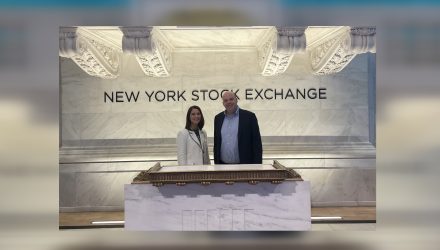It has been a tremendous start of the year for actively managed ETFs in 2023, which is cause for celebration. Indeed, this week executives from American Century, a leading manager of active ETFs, rang the closing bell at the New York Stock Exchange. VettaFi spoke to them to learn more about why demand has been particularly strong, and what this means for ETF liquidity going forward.
The strong demand we’ve seen for active ETFs so far in 2023 is a continuation of a trend for the last few years, but it was particularly notable in 2022. Last year, approximately 15% of flows into ETFs were directed to active ETFs, despite active ETFs representing only about 4% of assets. This year year-to-date through March, active ETFs were the recipient of over 30% of the industry’s flows.
“There are likely many reasons for this spike in demand,” explained Sandra Testani, vice president of ETF product and strategy for American Century Investments in an exclusive interview with VettaFi . “Three that we believe have contributed are 1) significant change in market environment to one that has been very challenging across multiple asset classes with high levels of uncertainty; 2) a desire for insights of professional management and ability to be opportunistic and flexible in the face of uncertainty; and 3) more high-quality active offerings from well-regarded, experienced managers available in ETF form.”
American Century is one of those firms and now offers a broad array of active ETFs under the American Century and Avantis brands. These include active equity funds like the American Century Focused Large Cap Value ETF (FLV), and the Avantis US Equity ETF (AVUS) as well as active fixed income ETFs like the American Century Multisector Income ETF (MUSI) and the Avantis Core Fixed Income ETF (AVIG).
Testani noted that active managers generally have the flexibility to invest across many sectors, and are able to nimbly and opportunistically adjust sector allocations based on the relative attractiveness of each opportunity. Similarly, active managers can invest across the credit spectrum when there are market dislocations or when their research suggests there may be a mispricing. Active managers also have the ability to manage duration based on interest rate forecasts, increasing or decreasing exposure along the yield curve based on the market outlook. Finally, active managers can take advantage of the new issue market.
Active fixed income demand is occurring, as the broader asset class has gained a strong following in the first quarter of 2023 while the market became volatile.
“Looking at year-to-date flows to the end of March, we are seeing $51 billion of inflows into fixed income ETFs compared to the same time frame last year with only $22 billion of inflows,” added Matt Lewis, vice president and head of ETFs implementation and capital markets. “Over time, the ETF vehicle continues to prove resilient in all types of fixed income market cycles, which leads to more users and hence a growth in volume and liquidity.”
American Century’s looks poised to benefit from further adoption of actively managed fixed income by advisors and end clients, which is a good reason to celebrate with us in New York.
For more news, information, and analysis, visit VettaFi | ETF Trends.


